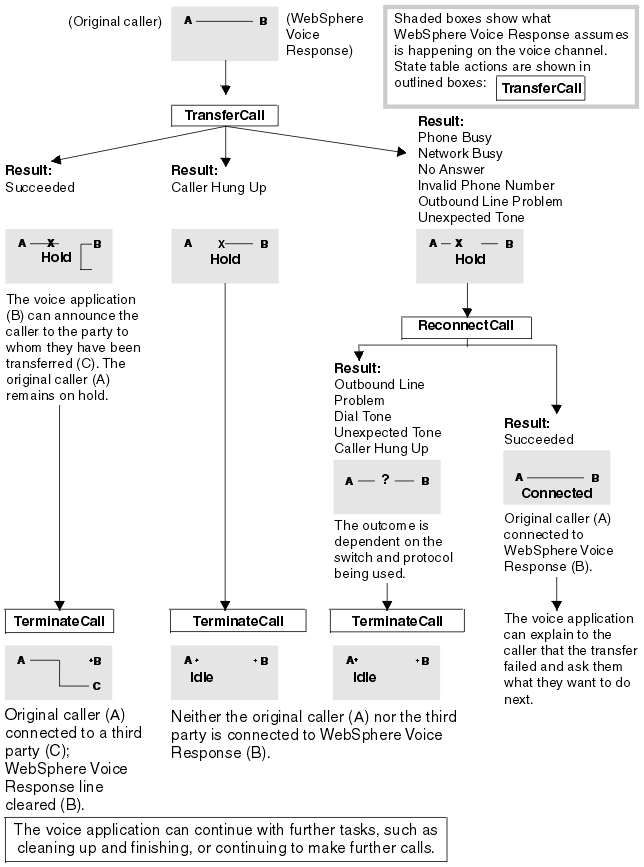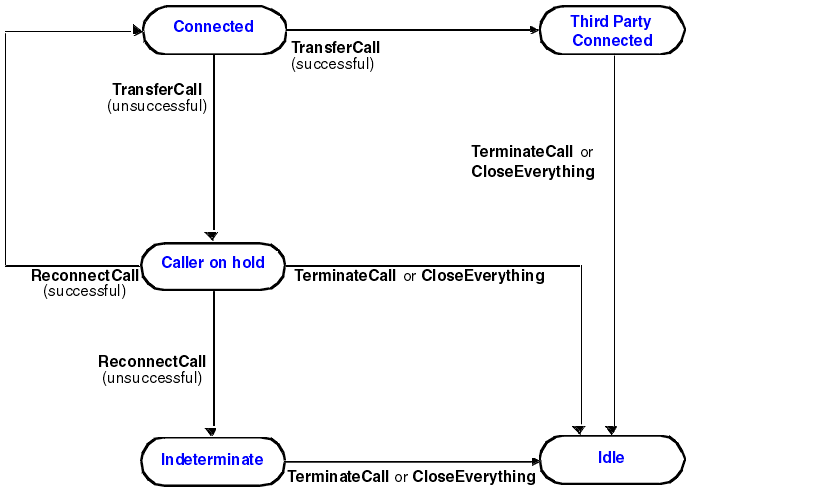The same call transfer model is used for both common channel and exchange data link signaling. Call transfer includes the transfer of an active call to a third party and the reconnection of the call if the transfer is unsuccessful. If the signaling process specifies that it is capable of supporting call transfer Blueworx Voice Response expects it to implement the call transfer model described here. Note that a switch may implement a different call transfer model from the one described here. The signaling process is responsible for mapping the Blueworx Voice Response call transfer model to that used by the switch.
There are two types of call transfer: screened or supervised transfer and blind transfer. With screened transfer, the application puts the existing party in a suspended state (on hold), and completes the transfer only if the call to the third party is answered. With blind transfer, the application puts the existing party on hold, and disconnects from the call after sending the address of the third party. The Blueworx Voice Response model is defined in terms of screened transfer.
A voice application may offer to transfer the caller to another number, for example, to transfer out of a voice mail application. An “automated agent” voice application may decide to transfer the caller to a human agent if they hesitate too long in choosing an option. The call transfer may or may not be successful. Figure 1 shows the possible outcomes and what the voice application should try to do in each case.
Blueworx Voice Response allows an application to transfer calls if the underlying telephony protocol supports call transfer. Blueworx Voice Response applications use the TransferCall and ReconnectCall state table actions to transfer calls. These actions are described in more detail in the Blueworx Voice Response for AIX: Application Development using State Tables information. To transfer a call, the application includes a TransferCall action in the state table, specifying the phone number of a third party. The TransferCall action is only meaningful for connected calls.

Figure 2 shows the call transfer states, and the allowable state transitions, in terms of the state table actions:
- If the TransferCall action succeeds, the original caller is placed on hold, and Blueworx Voice Response (and the state table) are connected to the third party. The state table can play an announcement to the third party. Once the state table hangs up, either by issuing the TerminateCall or the CloseEverything state table action, the original caller is connected to the third party.
- If the TransferCall action fails, the
original caller is assumed to be on hold, and Blueworx Voice Response (and
the state table) need to be reconnected to the original caller. The
state table reconnects to the original caller by issuing the ReconnectCall action.
If the ReconnectCall action succeeds, Blueworx Voice Response (and
the state table) is once again connected to the original caller. The
state table can play an announcement to the caller explaining that
the transfer has failed. If the ReconnectCall action
fails, the situation is indeterminate. In this case the state table
needs to clear the call, either by issuing the TerminateCall or
the CloseEverything state table actions. Figure 2. Call transfer model in terms of state table actions

The signaling interface includes primitives that correspond to the TransferCall and ReconnectCall state table actions. These primitives are SL_CALL_TRANSFER_REQ, SL_CALL_TRANSFER_CNF, SL_CALL_RECONNECT_REQ and SL_CALL_RECONNECT_CNF. Figure 3 shows the call transfer states, and the allowable state transitions, in terms of the signaling interface primitives. This is the model that signaling processes must implement to be compatible with Blueworx Voice Response.
If you are using the Nortel DMS-100 or DMS-250 you might be able to use the Blueworx Voice Response ISDN call transfer application. See the Blueworx Voice Response for AIX: Designing and Managing State Table Applications information for more information.
